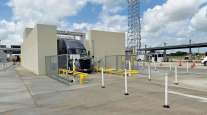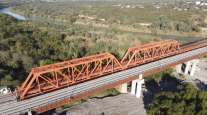Staff Reporter
Arizona DOT Trains Mexican Fleets, Expedites Border Inspections

The Arizona Department of Transportation has significantly reduced wait times for trucks moving through border inspection facilities using training programs geared toward Mexican fleets.
Through its Border Liaison Unit and the International Border Inspection Qualification program, ADOT officials train Mexican truck drivers on the state’s highway safety requirements, covering topics from tire wear and brakes to securing flatbed loads. Some 280 truckers have passed the course since its inception two years ago, and the border inspection program continues to take on new trainees.
According to ADOT spokesman Tom Herrmann, these 280 drivers have crossed the border about 1,500 times. He said five of those 1,500 crossings, which is less than 1%, have resulted in stops for service repairs.
“We’re being much more efficient with our inspections. Trucks meeting safety standards are not held up longer than necessary. That’s a benefit to the Mexican trucking companies because they’re not being stopped at the border and sitting idle while repairs are being made,” Herrmann said. “There’s a lot of motivation for companies. Time is money, and they don’t want to spend any more time in inspections than they have to.”
Mexican trucks moving into the United States are confined to border commercial zones, or areas surrounding certain border cities. The Federal Motor Carrier Safety Administration determines these zones using a formula based on population size of the municipality along the border.

A safety inspector guides a truck into a inspection stall at the Mariposa Port of Entry in Nogales. John Miller/Associated Press
Through the border inspection program, agency officials travel into Mexico and conduct two-day classes that culminate with a test that includes a written component and a practical exam involving an actual truck. Herrmann said the success rate on the test is about 95%.
Martha Rascon Overpeck, head of the Safe Border Trucking Association, said the program has helped build rapport among Mexican freight movers and U.S. law enforcement officials. Based in Nogales, Ariz., Safe Border Trucking Association represents transportation companies. Herrmann said many of the inspectors are former law enforcement officers, and all of them speak Spanish.
“They see when they cross the border that they will be inspected by [ADOT] officers that speak the same language in terms of how they are going to inspect the truck,” Overpeck said. “It’s much more friendly. Things have changed. Things have improved. There is more confidence and more response from both sides.”
In 2017, ADOT officials made eight trips into Mexico to run sessions. Herrmann said they had originally planned four classes, but demand was so high that they doubled their schedule. The department has set up more sessions in 2018, the next of which is set to convene in early April. More than 1,000 drivers are currently receiving training.
“Keeping in mind the trucks are safe on our roads, we want these drivers to pass. The goal here is to get as many drivers through as we can who are going to be trained, understand the safety procedures and make sure their trucks are going to make the requirements when they cross the border,” Herrmann said. “We’re getting regular requests for more classes.”
Using the messaging service WhatsApp, drivers who have completed the program can send pictures of their trucks to inspectors, who can make suggestions about repairs. Herrmann said most inspections take 15 minutes, but more intensive ones require a 37-point checklist and can take up to an hour.
According to the Bureau of Transportation Statistics, Arizona has six ports of entry along the U.S.-Mexico border: Douglas, Lukeville, Naco, Nogales, San Luis and Sasabe.
Nogales, located 70 miles south of Tucson, is the busiest, with more than 333,000 truck crossings in 2017. The next busiest is San Luis, which had more than 31,000 truck crossings in 2017.
Although Herrmann said safety is the top priority, he acknowledged the economic boost the International Border Inspection Qualification program can offer Arizona. He said Nogales, which links to Interstate 10, is particularly important for winter produce.
Herrmann also said the program has given ADOT officials the opportunity to turn their attention to other trucks that need help maintaining safety standards, such as those with a history of violations.
“We obviously want the economic boost that comes from trucks coming into Arizona. We believe it’s advantageous to the trucking community in these parts of Mexico to come in through Arizona and get on I-10 and get from there to wherever they’re trying to reach,” Herrmann said. “We’re trying to provide this service to help people on both sides of the border. It allows us to focus on the trucks that haven’t gone through the program.”




